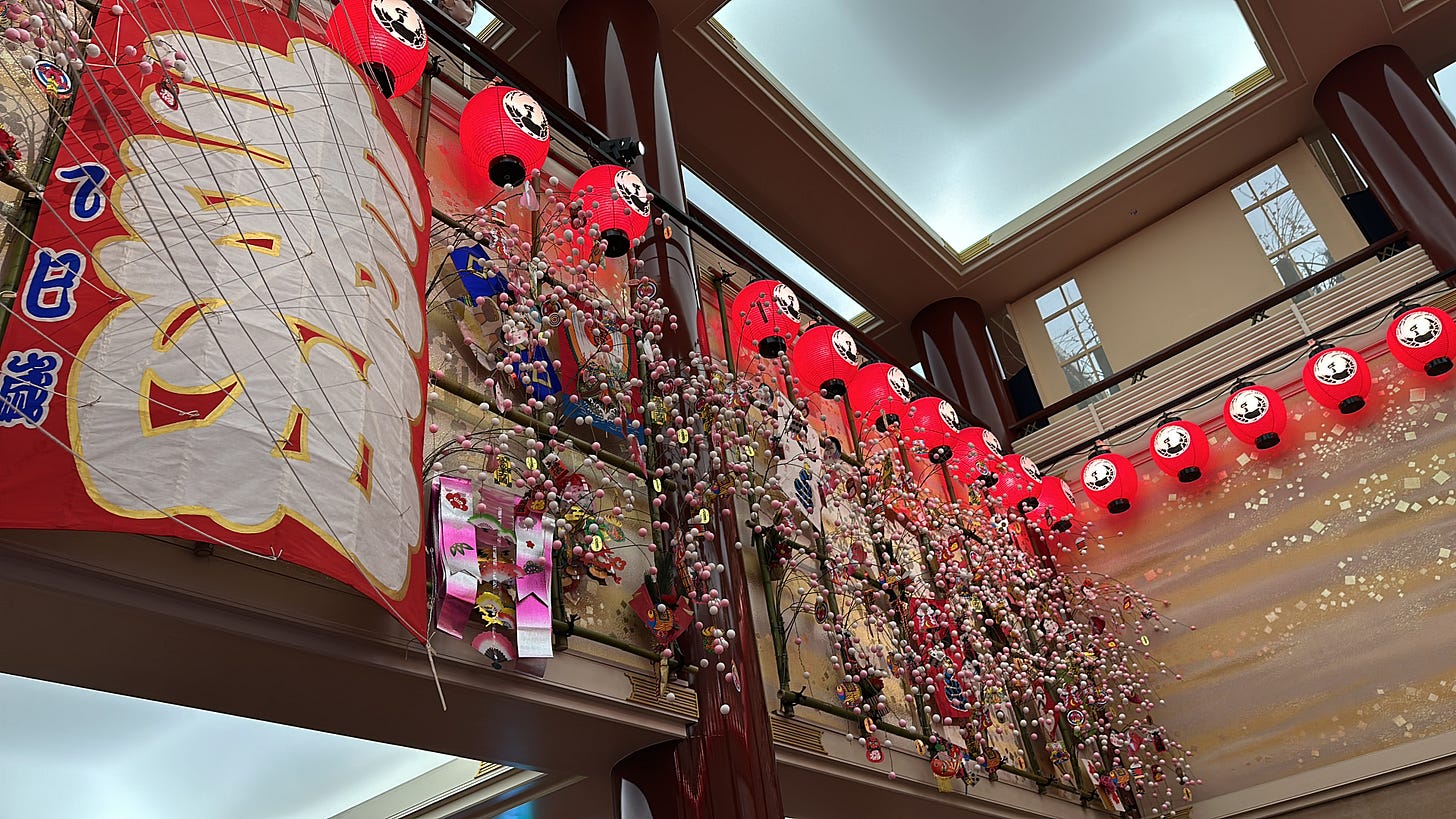Since 1709, it has been the tradition in Japan for kabuki theatres to kick off the New Year with a revenge drama centered on the Soga brothers—a pair of avenging siblings—and their nemesis, Suketsune, the man who killed their father. These are the so-called sogamono subset of period pieces called jidai mono, usually set in Medieval Japan. On 2 January, I was at the Kabuki-za for the first kabuki of 2025, which opened with a performance of Kotobuki Sōga no Taimen.
Props to the Japanese for this. Many cultures look to the New Year as a way of wiping the slate clean and launching into the virgin snow of January; the Japanese kabuki stage stands resolutely against this. Here, the New Year isn’t about forgetting; it’s about vividly remembering—and doing so with flair.
Kabuki, artistically, is to me the creation of a time-defying hallucination. Sometimes, watching it feels acid-induced, phantasmagoric. Everything about it works to knock you off your perch.
The speech, for instance, is stylised and arcane; the average Japanese person does not follow it off the cuff and this stuff is generally more recent than Shakespeare. The costumes blaze in eye-popping colors, laden with symbolism; the sets and lighting achieve a level of literal and figurative brilliance that borders on the cartoonish. Physical action, too, is wildly artificial but compelling, viz. two samurai retainers grandly miming the opening of the shoji walls, while two stage-hands in black do what the actors could easily have just got on with.
For all the surreality, however, it is all utterly conventional. You can watch an explainer of the play I saw here on one of my favourite YouTube channels, Kabuki in Depth:
I recognise just about everything in that video from what I saw a few days ago. Those blue and red costumes the brothers wear. The exquisite staging. It’s all identical.
What I found most remarkable about this particular piece, though, is that in the midst of all this spectacle, almost nothing happens. The entire plot boils down to this: it’s 1193; the Soga brothers arrive at Suketsune’s mansion, ready to settle the score with blood. Suketsune, however, politely informs them that he’s a bit too busy to be avenged today and suggests they come back later; he gives them tickets to the hunt on Mt. Fuji where they might have a crack. That’s effectively it. That’s the whole story.
And yet somehow, this slender thread of narrative stretches feverishly across the hour, embroidered with poems, colours, digressions, sake. One odd, delightful moment comes when Suketsune’s retainers debate at length whether or not they should laugh at the Soga brothers’ arrival. After deciding they should, they give a nine-gun salute of monotone laughter. Then stop.
The pinnacle of the play is the mie pose at the end. The mie is a peculiarity of kabuki; a grand pose struck by one or more actors. Time stops. They are amplifying the emotional resonance of the drama that has come before. They are becoming symbols. They are showing their skill as actors and inviting the audience to shout about it. It’s really something.
Here, the Soga brothers resign themselves to postponing their vengeance, forming a tableau meant to depict Mount Fuji itself. Suketsune, meanwhile, strikes a pose symbolising a flying crane. This isn’t just posturing for posturing’s sake; in the extended mythology of kabuki (and the historical Genpei Wars on which it’s based), the brothers eventually get their revenge on Suketsune during the New Year hunt. This final mie foreshadows that climax, imbuing the moment with an eerie, evocative power when it is recalled that Suketsune appears to be going willingly to his death. Recall the opening of the Tale of the Heike, the great epic of the Genpei Wars which ended fifty years or so before the events of the drama: the Gion bells toll the passing of all things. For high and low, death and consequence cannot be avoided. So Suketsune, while being proper to form, goes magnanimously to his fate.
And we the audience go magnanimously to the drinks stall for beer and beef stew, and to see the crowds of elegant kimono-ed ladies.
For all its strangeness, I couldn’t help but draw comparisons to other theatrical traditions. Greek drama came to mind, with its own stylistic conventions and shared cultural narratives - see, eg, the inevitability of fate - as did Kathakali, the Keralan theatre form where everyone knows the stories, and the artistry lies in how the conventions are deployed. Kabuki, like these forms, creates a world more stylised than real, and that heightened artifice, I think, makes it all the more compelling.
So, what vengeances are you planning to enact in 2025? Take inspiration from the Soga brothers: revenge is a dish best served dramatically. When the moment comes, strike the perfect pose before you exact your righteous justice. Happy New Year.






Hmmm... this has me thinking! I normally enact my grudges through short stories. So many people murdered and tortured. Yet I'm not in jail.